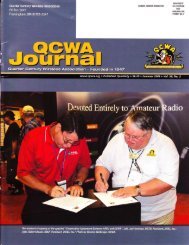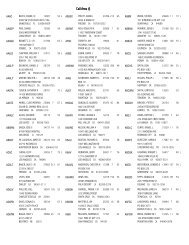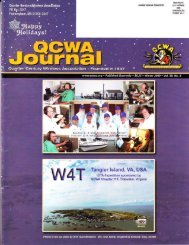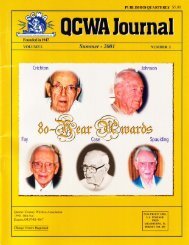Untitled - Quarter Century Wireless Association
Untitled - Quarter Century Wireless Association
Untitled - Quarter Century Wireless Association
You also want an ePaper? Increase the reach of your titles
YUMPU automatically turns print PDFs into web optimized ePapers that Google loves.
Amateur Radio Satellite News<br />
By: Keith Pug[ W5ru, Vice President of Operations, AI4SAT-NA.<br />
n recent olumns I have talked about a number of the currently<br />
active Amateur Radio Satellites, but it has been a long time<br />
since a complete list of the Amateur Radio Satellites has been<br />
pnblished in thisjournal or any other for that nntter. This column<br />
will be devoted to a brief description of the ..active birds,' and<br />
souroes of information about tlre Amateur Radio Satellite program.<br />
Active Amateur Radio Satellites: The Journal Hitor<br />
informed me that a roquest had been made for an alphabetical<br />
li*ing of the active amateu radio satellites in a couple of lines.<br />
Here are the lines: AO.l0, AO.13, A0-16, AO-21 ES-14), AO-<br />
27, ARSENE, DGIT (DO\18), FO-20, 1026, Ko}3, KO.25,<br />
LG.19, N4IR, POSAT (pG.28), Rs-loill, RS-12/13, UO-11, UO.<br />
22,andWO.l8.<br />
The above oompct list itlustrates the number of amateur<br />
radio satellites currently activg but it does not tell the whole $ory.<br />
For this issue only, a tabular listing outlining a few more details is<br />
incluMasTablel.<br />
As you (itn see, in Table I, amateur radio satellites conp<br />
from a variety of plaoes, serve a rariety of functions, and most live<br />
Iong lives. ARSENE, unforhmately, appears to have been slrort<br />
livo( but it has not been crossed off completely yet. A few of the<br />
others have degraded with time, but are still flrnctional in at least<br />
one mode.<br />
A few words of explanation are in order for some of ttp<br />
entries. A MOLYNIA orbit is a high altitude elliptical orbit ttut is<br />
usefirl forreal timeDX. Manypoople haveworked DXCC through<br />
tlre'birds". A LEO orbit is a Iow Earth O6it, usually polar or<br />
NAME<br />
AO-r0<br />
uo-ll<br />
MIR<br />
RS-10/11<br />
AO-13<br />
RS-12/13<br />
AO-16<br />
DO-17<br />
wo-18<br />
LO-19<br />
FO-20<br />
AO-21<br />
uo-22<br />
KO-23<br />
ARSENE<br />
KO-25<br />
1o,-26<br />
AO-27<br />
POSAT<br />
Table I: ACTIVE AMATEUR RADIO SATELLITES<br />
at least fairly high inclination. LEO satellites terd to be much<br />
easier to worft due to their relatirrely short range from yor station;<br />
horryever, their real time communication range is much shorter<br />
than a MOLYNIA'bird." The LEOs are ideal for digital $ore and<br />
foruard applications (flyrng mailboxes).<br />
Three broad tpes of satellites are listed. ANALOG<br />
mqms a lineartransponder is canied on the satellite and any mode<br />
normallyused on IIF can be used through the tansponder. One<br />
word of cautioq please use only low duty cycle, rurow bandwidth<br />
modes such as SSB and CW. FM is a "hog,' on two counts so don,t<br />
use it on the analog 'birds." DIGI. means a digital transponder<br />
capable of Packet Rdio Communications. A & D nrears both<br />
Analog and Digital transeonden are available. EDU. means<br />
Educatiorul. Tlrcse'birds" are useful as educatiorul denpnstration<br />
tools. They are usully receive only "birds." The oommand station<br />
can change ttre sntents of any nressages and operating modes, but<br />
the user can only listen.<br />
Shtellite MODES are aluays oonfusing to the newcomer,<br />
but ttry are really a oonvenient "shorthend" method of eryressing<br />
tte uplink and downlink bands. For example: MODE ',A" is 2m<br />
up ard 10m down. MODE "B" is 70cm up and 2m down. MODE<br />
"S" is 70cm up ard l3cm dolvn. MODE "K' is l5m up and 10m<br />
do\iln. MODE "I'is 2m up ard 70crn down. Otlrer nrcdes reside<br />
in some of the'birds," hrt these are the orrently used mtr. This<br />
whole mode sctreme will be overhauled with the advent of phase<br />
3D. More about that later.<br />
ORBIT TYPE MODES LAUNCII NATTONALITY<br />
MOLYNIA<br />
LEO<br />
LEO<br />
LEO<br />
MOLYNIA<br />
LEO<br />
LEO<br />
LEO<br />
LEO<br />
LEO<br />
LEO<br />
LEO<br />
LEO<br />
LEO<br />
GEO DR.<br />
LEO<br />
LEO<br />
LEO<br />
LEO<br />
ANALOG<br />
EDU.<br />
MANNED<br />
ANALOG<br />
ANALOG<br />
ANALOG<br />
DIGI.<br />
EDU.<br />
EDU.<br />
DIGI.<br />
A&D<br />
A&D<br />
DIGI.<br />
DIGI.<br />
A&D<br />
DIGI.<br />
DIGI.<br />
A&D<br />
DIGI.<br />
B<br />
2m Rec.<br />
2m FM<br />
A (PRr.)<br />
B,S<br />
K (PRI.)<br />
J<br />
2mRec.<br />
J<br />
J<br />
J<br />
B<br />
J<br />
J<br />
2m&S<br />
J<br />
J<br />
I<br />
J<br />
1983<br />
1984<br />
1986<br />
1987<br />
1988<br />
1989<br />
1990<br />
1990<br />
1990<br />
1990<br />
1990<br />
l99l<br />
1991<br />
1992<br />
1993<br />
1993<br />
1993<br />
t993<br />
1993<br />
MI.JLTI<br />
UK<br />
USSR<br />
USSR<br />
MULTI<br />
USSR<br />
USA<br />
BRAZIL<br />
USA<br />
ARGENTTNA<br />
JAPAN<br />
USSR& GER.<br />
UK<br />
KOREA<br />
FRANCE<br />
KOREA<br />
ITALY<br />
USA<br />
PORTUGAL<br />
33 Spring 1994




![11{J hI EfifSIt]E I]E - Quarter Century Wireless Association](https://img.yumpu.com/11816560/1/190x245/11j-hi-efifsite-ie-quarter-century-wireless-association.jpg?quality=85)




